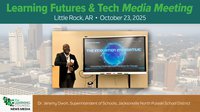Anyone who grew up watching "The Brady Bunch" remembers Jan's exasperated cry: "Marcia, Marcia, Marcia!" The quintessential middle child, overshadowed and forgotten.
Middle school is our education system's Jan Brady. And the data proves it: chronic absenteeism increases by more than 50% between fifth and eighth grade. One in four middle school students reports being bullied. Only half have a trusted adult at school they can turn to when they have a problem.
We're watching middle schoolers fall through the cracks in real time.
The Middle School Slide
Fifth grade is the K-12 attendance sweet spot, with chronic absenteeism at around one in seven students. Then comes sixth grade, and the numbers start to slide. By eighth grade, more than one in five students is chronically absent. The transition to middle school marks the beginning of a steady drop in attendance that doesn't stop until we reach one in three students chronically absent.
Social and emotional data are equally concerning. YouthTruth's 2025 Anti-Bullying Report found that 25% of middle schoolers experienced bullying in the past year. Between sixth and eighth grade, the percentage of students who feel part of their school community drops 11 percentage points. By eighth grade, fewer than half feel connected.
More than 75% of bullied students pointed to their appearance as the reason. Many others reported being targeted because of their race, presumed sexual orientation, family income, disability, religion, or where their family is from. This is the daily reality for millions of 11, 12, and 13-year-olds.
Outdated by Design
The data’s clear—but so is the reason. We built middle schools for a world that no longer exists. Middle school as we know it emerged in the 1970s and '80s with good intentions: early adolescents are developmentally distinct and needed schools designed around their unique needs. Four decades later, we still have the structure, but the world has changed dramatically. Social pressures that previous generations faced in hallways now follow kids home through their phones, amplified by social media, around the clock.
Some districts are rising to meet this moment. Take Pecos-Barstow-Toyah Independent School District in Texas. Nydia Natividad, their Director of Communications, recognized the traditional approach wasn't working.
“When I started working in education, I quickly learned that transitional years are the toughest for students,” Natividad explains. “Our middle school does a great job engaging students, but we also really need those parents.”
Rather than pulling back on family engagement, the district doubled down—launching a newsletter that now reaches more than 1,100 families and relaunching the middle school PTO. “The biggest thing we hear from parents is, ‘Why does the fun stop after elementary school?’” says Natividad. “Middle school parents want to be involved. When you invite them in, they become more informed and better equipped to support their kids through all those high-hormone, high-emotion years.”
Research backs this up. Districts seeing the best results maintain and strengthen family engagement throughout K-12, rather than loosening those connections.
The solutions aren't complicated, but they require intentionality. Advisory groupings ensure every student has a trusted adult and consistent peer group. Student government gives young people real agency in shaping school culture. Professional development helps teachers understand early adolescents and make classrooms more responsive.
Perhaps most importantly, schools need adults who consistently model respect across all kinds of differences. YouthTruth's research found that when middle school students see this, reports of harmful behavior drop significantly. Seven in ten students already report seeing this at their schools. The opportunity is to make it universal.
The Brady Bunch aired from 1969 to 1974, right as educators were rethinking junior high schools. Two cultural artifacts of the same era, both now outdated. The educators designing middle schools in the 1970s and '80s couldn't have imagined a world where social pressures follow kids home through their phones 24/7, where every insecurity gets amplified online.
The data tells us that 6th grade represents a critical turning point. What happens during that transition year determines whether students follow a trajectory toward engagement or toward disconnection and chronic absenteeism. Yet too many middle schools are operating with structures designed for 1980, serving students living in 2025.
Unlike Jan, today’s middle schoolers shouldn’t have to shout to be seen. They deserve adults who notice them before crisis hits, schools where every student has a trusted adult, structures that honor the social and emotional complexity of early adolescence in a digital age, and families who stay engaged through it all.
Districts that sustain strong family connections throughout K-12 see better attendance and stronger engagement. Schools where adults consistently model respect see harmful behaviors drop. These aren't aspirational goals for next year. Middle schoolers need us right now, and these proven strategies are working in districts across the U.S.
Middle school will always be messy. That's developmentally appropriate. But too many students falling through the cracks isn't. The data shows us what to do. What we need now is the collective will to act before another cohort of 6th graders becomes another set of alarming statistics.
About the author
Dr. Kara Stern is Director of Education at SchoolStatus. She spent 20+ years in schools, eight of them as a middle school principal. She earned a Ph.D. in Teaching and Learning from NYU.











